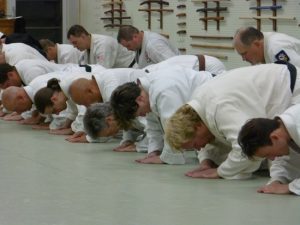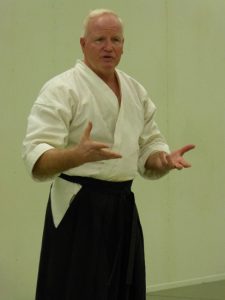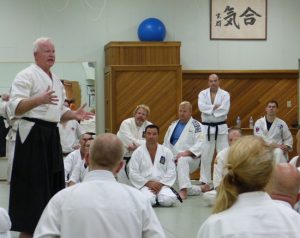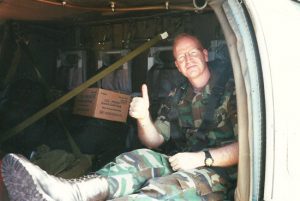
It’s a little like entering that ride on the midway, you know, the one that’s as dark as the inside of your hat. You can barely make out shapes or forms, but that’s all they are. And it stays that way until you’ve made your way all the way through. I felt a little like that the day I entered what’s known as a dojo in Windsor, Ontario. Not that it was the least bit threatening, just slightly intimidating.
“Welcome to Aikido Canada,” the man in the martial arts robe said. “I’m Kevin Blok.”
“Oh, Chief Instructor Blok?” I confirmed.
“Yes,” he continued. “Take off your shoes and join us.”
See what I mean? I didn’t even know, entering the dojo (literally “the place of the way” in Japanese), the first thing I needed to do was take off my shoes. Of course, that’s my fault. I hadn’t done my homework, to find out what the protocol was inside a dojo. There was also a bowing ritual. I wasn’t dressed the way the martial arts students were, but on entering or exiting the training area, each one bowed and then proceeded. The fact was, however, I wasn’t there to meet either Chief Instructor Blok or his students. I had an appointment with one of Blok’s guest instructors – Sensei Dane Harden (sensei meaning martial arts teacher).

Actually, Harden isn’t just a teacher; he’s a master. Beginning at the age of 10, he has spent much of his 59 years deeply connected to Japanese martial arts. According to an American martial arts website, Harden has a black belt in Aikido and a seventh degree black belt in Tae Kwon Do. He has also been awarded the Shidoin rank, meaning “person of the way,” with credentials as a certified instructor with promotion authority. And, in his time, he has competed in such full-contact tournaments as The Battle of Atlanta, The U.S. Diamond Nationals and The Battle of Baltimore. And as impressive as all those titles are, I had no idea what they meant … except that I should make an all-out effort to be his friend, not his enemy. And that’s where I came in.
“As martial arts instructors,” Sensei Harden told the dojo full of students and fellow Aikido teachers, “we face student training injuries and we need to know how to manage them.”
Now here was something I could relate to and part of the reason I wanted to meet him. He said those who can teach martial arts must also know how to respond to the impact of those arts – things such as concussions, bleeding wounds and violent joint sprains. He started with the head, suggesting the ways to prevent serious damage was to require head gear, mouth pieces, gloves and so on.

Then he addressed the likelihood of bleeding wounds. First, he said, do a “primary survey,” or the “A, B, C, D, E and F approach,” as in Airway, Breathing, Circulation, Disability and Exposure and Follow-up of the injury. And he rattled these off as quickly as the letters of the alphabet. Why? Because, in addition to all of the man’s martial arts credentials, he is also a military medic.
That’s why I wanted to meet him. As a professional soldier, Dane Harden has served 23 years on active duty in the Army National Guard and as a senior flight surgeon with the U.S. Army on deployments as varied as Estonia, Bosnia-Herzegovina, Iraq, Afghanistan and Hurricane Katrina.

After he had completed his sessions with students and fellow instructors at the Aikido Dojo in Windsor, Harden and I sat down for a lengthy interview. I guess, for starters I wanted to know how the martial arts played into his work a military medic.
“It’s vital,” he said.
“For saving the lives of soldiers in combat?” I asked.
He related several instances during which he was flown into war zones in Eastern Europe and the Middle East to retrieve wounded troops and bring them out alive. That meant when stretcher bearers delivered patients to his medical-evacuation Blackhawk, he would then have to deliver first-aid – amid the noise and vibration of the helicopter – using many of the same techniques he taught in the martial arts class. There could be brain injury, loss of limbs and severe shock to address. And he could do all that in the middle of a whirlwind of machinery, trauma and emotion. Sometimes, he admitted, those same techniques helped him.
“You can’t manage all that upheaval,” he explained, “without the potential calming skills of the martial arts training.”
I still had much to learn about the man, the martial arts and the methods he had come to master. It still felt a little like that midway ride in the dark. But I began to understand why he was so respected in the martial arts world. He is that rare individual who teaches by doing.
Great article!
Sensei Dane Harden is a great guy. Hanshi Kevin Blok is a gifted teacher and that’s why I’m so proud to call him my instructor.
I’m happy to say that I can’t remember the last time someone bled in my dojo. I think it was due to an unexpected nose bleed one of my younger students got during a class when they were lined up to play a game.
I’ve never seen a “violent sprain” at our school.
I won’t say we haven’t seen injuries. Years ago, one of my students got a concussion that was non-Karate related, but still occurred during a class.
Martial art training has come along way and is one of the safest activities one can do. We used to sponsor youth soccer. I was surprised to see how many kids were carried off the field with bruises and injuries.
Truth is, you can get injured more playing golf than doing Aikido. For example, we don’t get sunburns or bee stings.
I know I introduced you to Dane, but if you’re brave enough to seriously investigate martial arts, I’d love the opportunity to introduce you to Aikido!
All you have to do is contact me…and be willing to take off your shoes again.
Wonderful article. I was looking for few queries and here. I have got those answered. Thanks for sharing.
I heard of him from my friend. He is a great instructor.